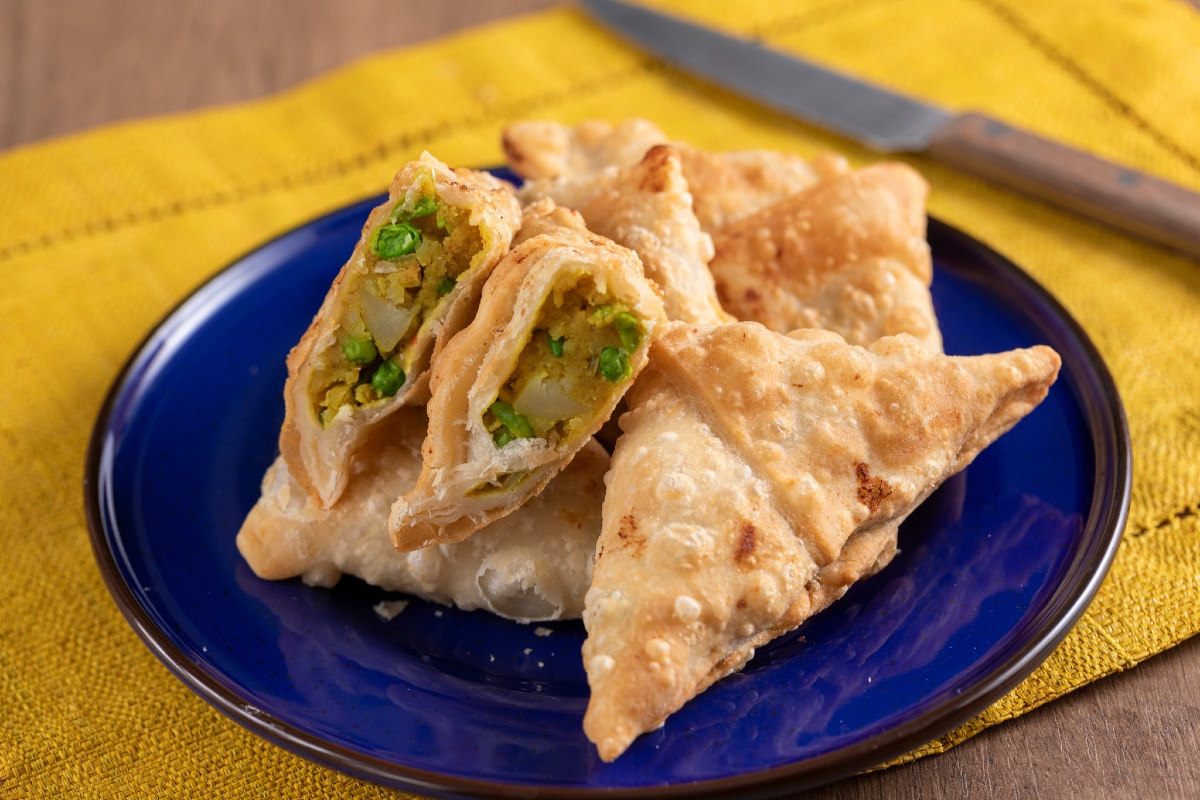Japanese Gyoza (Meat Dumplings)
- Difficult
- 45 min

Whether you are traveling on the bustling streets of the Indian subcontinent or lost among the thousand scents of a Southeast Asian market, you will undoubtedly come across samosas, inviting pastries with a soft, spicy filling! This popular street food is believed to have originated in the Middle East, but thanks to ancient trade routes, it has become one of the most beloved snacks in Asian cuisine. Vegetable samosas are one of the most common and widespread vegetarian variants: they essentially consist of a fragrant pastry shell that is fried and filled with an extremely customizable mix of potatoes and vegetables, to which meat or legumes can also be added depending on the origin or religion of the family preparing them. Since there is no official recipe, we decided to offer you a vegan version of the filling made with potatoes, peas, and onions, but you can adapt it to your taste by adding or removing the ingredients you prefer... try for example our tuna samosas! Serve the samosas as a delightful appetizer for an ethnic dinner along with the typical Indian naan bread or as a spicy snack for an exotic aperitif, perhaps accompanied with a delicious cherry tomato chutney or a refreshing yogurt sauce like raita, and guide your guests along new and intriguing paths of flavor... then, tell us about your journey!
Discover these Indian dishes as well:

To prepare the samosas, first wash and peel the potatoes 1, then cut them into 3/4-inch cubes 2 and boil them in water for about 30 minutes, or until they are soft 3.

In the meantime, prepare the dough: in a bowl, combine the flour, salt 4, water 5, and vegetable oil 6.

Mix with a spoon 7 to obtain a rough mixture 8, then knead the dough with your hands until you get a smooth ball 9. Cover and set aside.

Now, clean and chop the onion, then add it to a pan with the oil 11 and the crushed garlic cloves 12.

Add the dried chili 13, turmeric 14, and garam masala 15 and let it fry for a few minutes.

Add the cooked potatoes 16, peas 17, then mash the potatoes with a fork 18.

Adjust the salt 19, turn off the heat, and let it cool. Meanwhile, take the samosa dough and divide it into 4 equal parts, each weighing about 3.5 oz 20. Lightly flour the work surface and roll out the first portion of dough with a rolling pin 21.

You should form a disk with a diameter of 8 inches 22. Cut it in half to get 2 semicircles 23, then brush the edges with water 24.

With the base facing down, fold the first flap inward 25, then do the same with the other flap, slightly overlapping them and making them adhere 26. This way, you will obtain a sort of cone that you hold in one hand, placing it between your thumb and index finger, with the opening facing up 27.

Insert the filling into the samosas with a spoon 28, then use your fingers to push the filling down, leaving about 3/8 inch of free edge to facilitate closure 29. Brush the edge with water 30.

Close the edges well to seal the filling inside and prevent it from coming out during cooking 31; you should create the shape of a filled pastry triangle 32. Proceed this way to form all the samosas and place them standing on the lightly floured work surface 33. With these quantities, you will obtain 8 samosas.

You are ready to fry: heat the vegetable oil to a temperature of 320°F-338°F and immerse 1-2 samosas at a time 34. Fry the samosas for 3-4 minutes, turning them gently in the hot oil. When they are beautifully golden and have characteristic bubbles on the outside, drain and transfer them to paper towels 35. Proceed in this way to fry all the samosas 36, then enjoy them while they're still hot and crispy!